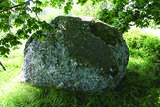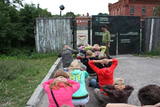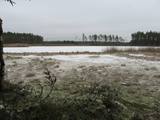| Nr | Nosaukums | Apraksts |
|---|---|---|
|
Saulkrastos netālu no Baltās Kāpas un Saulrieta takas posmā no Bērzu ielas līdz Selgas ielai gar jūru izbūvēts jauns pastaigu takas posms un izveidots vides objekts “Saulrieta vērotājs”. Tas ir foto objekts, kur jaunlaulātie un ikviens Saulkrastu iedzīvotājs, viesis var iemūžināt atmiņas Saulkrastiem tik raksturīgajā saules simbolā. |
||
|
Traķu pirmsākumi ir meklējami Senajos Traķos, kas atrodas 4 km dienvidaustrumos no Traķu centra. Uzskata, ka Senos Traķus ir dibinājis Lietuvas dižkunigaitis Ģedimins (~ 1275. – 1341.) 14. gs. pirmajā pusē. 14. gs. otrajā pusē šeit uzcēla mūra pili, no kuras līdz mūsdienām ir saglabājušies tikai nostāvināti zemes vaļņi. Laikā no 1345. – 1382. g. tajā valdīja Ģedimina dēls – Ķēstutis (1297. – 1382.). Senajos Traķos dzimis arī viens no izcilākajiem viduslaiku Lietuvas valdniekiem – Ķēstuta dēls - Vītauts Dižais. Kā pilij, tā arī tās valdniekiem bija nozīmīga loma sekojošajos krusta karos un cīņās. 1391. g. pils tika sagrauta cīņas laikā ar Vācu ordeni, kādēļ arī zaudēja savu stratēģisko nozīmi. 1405. g. benediktīniešu mūki šajā vietā uzcēla baznīcu, bet 18. gs. beigās - jaunu un lielāka apjoma klosteri, kura vienu no korpusiem 1889. g. pārbūvēja par baznīcu. |
||
|
Žīguru pagasta bērnudārza telpās ir iespēja iepazīt meža dzīvi gida pavadībā. Muzeja saimnieces stāsti par mežu un meža iemītniekiem neatstās vienaldzīgu nevienu. Annas Āzes Meža muzejs — ekspozīcija, kas piedāvā apmeklētājiem mazu gabaliņu no pārsteigumiem bagātās Latvijas meža pasaules - tika atzīts par ģimenes atpūtai tīkamāko vietu Latvijā.
|
||
|
Viens no retajiem brīvdabas objektiem, kas liecina par pasaules mērogā unikālo Baltijas ceļu, kur rokās un vienā ķēdē sadevās trīs valstu – Lietuvas, Latvijas un Igaunijas iedzīvotāji. Piemineklis atrodas pie bijušā Unguriņu robežas pārejas punkta pie Latvijas – Igaunijas robežas. Uzstādīts 2009. gada 23. augustā, Baltijas ceļa 20. gadadienā. To veidojis metālmākslinieks Andris Dukurs. |
||
|
Kennu Alpaku fermā jūs varat redzēt Peru izcelsmes alpakas, brīnišķīgus dzīvniekus ar biezu un mīkstu vilnu. Kamēr esat šeit, jūs varat pabarot šos dzīvniekus ar našķiem, kurus piedāvā īpašnieki, un paglaudīt tos. Fermā arī atrodas kazas, truši, vistas un aitas. Veikalā jūs varat iegādāties suvenīrus un alpaku vilnas produktus. Kennu Alpaku ferma ir piemērota visai ģimenei. |
||
|
Meklējama Nīcgalē, starp Rīgas – Daugavpils šoseju (A 6) un Daugavas krastu. Baznīcu cēla (neogotikas stils) pēc muižnieka Henriha Plātera - Zīberga iniciatīvas 1862. - 1863. g., veltot to Jaunavas Marijas dzimšanai. Kā jau daudzas citas baznīcas, arī šī ēka un tās interjera priekšmeti cieta 1. pasaules kara laika notikumos. To atjaunoja 1922. gadā. Baznīcas iekārta ir saglabājusies no 19. gs. 60. gadiem, bet, centrālā altāra augšdaļu pārbūvēja 1957. gadā. Dažus gadus vēlāk - 1961. g. uzstādīja ērģeles. |
||
|
No Sv. Sīmaņa luterāņu baznīcas torņa labi saskatāma Valmieras centrālā daļa un Gaujas krasti. Skaidrā laikā redzams Zilais kalns. Apskatāmas arī baznīcā esošās kultūrvēsturiskās vērtības un vienas no Latvijas skanīgākajām ērģelēm.
|
||
|
Akmenī iekaltais teksts (vēl nedaudz saskatāms) ir vēstījums nākamajām paaudzēm par tā laika vietējo mācītāju (kurš mira no mēra), par pastorāta izveidi Sīkragā, ko drīz vien pārcēla uz Mazirbi. Tas ir arī piemineklis sešiem plašākas apkārtnes draudzes mācītājiem. Visi trīs (sk. iepriekš) mēra akmeņi vēstī par 1710. gada Lielo mēri un teksti akmeņos iegravēti Mazirbes mācītāja Petrsona laikā no 1711. līdz 1734. gadam. |
||
|
Atrodas Daugavas prospektā 10, starp Rīgas – Daugavpils šoseju (A 6) un Kalēju ielu. Dievnams celts laikā no 1931. - 1933. g. (arhitekts: Pēteris Kundziņš). Padomju gados tajā bija izvietota Latvijas Valsts bibliotēkas grāmatu glabātava. Pateicoties draudzes aktivitātēm 1989. g., ēku atjaunoja. Tagad tā kalpo savam pamatmērķim. |
||
|
Kaut arī muiža sāka veidoties 16. gs., tagad redzamais komplekss tapis g.k. laikā no 1897. – 1902. g. un bijis grāfa Jozefa Tiškeviča un viņas sievas īpašums, kas tāpat kā daudzi citi, pēc 1940. g. tika nacionalizēti. Arī muižas liktenis līdzinās daudzu Baltijas valstu muižu piedzīvotajam. Sākumā te bija sanatorija, pēc tam – pionieru nometne, bet vēlāk - valstij piederošs tūrisma uzņēmums. 1995. g. muižas kompleksu savā pārraudzībā pārņēma nacionālā parka administrācija. Neorenesanses stilā celtā pils ir labi redzama pāri Galves (Galvė) ezeram no Traķu ezerpils puses. Užutraķu muiža ir iecienīta dažādu kultūras un mākslas pasākumu norises vieta. 2011. g. šeit notika vērienīgi muižas un skaistā parka ar dīķiem un skatu laukumiem (veidojis franču biologs E. F. Andrē) rekonstrukcijas darbi. No Traķu centra līdz Užutraķu muižai var ērti nokļūt ar divriteni. |
||
|
Mājas saimniecība „Pie Tēvoča Garika" piedāvā iepazīties ar nelielu dzīvnieku kolekciju. Dažus dzīvniekus var pabarot un paglaudīt. Te iespējams apskatīt gan mājas dzīvniekus, gan savvaļas dzīvniekus. Par katru dzīvnieku sniedzam informāciju. |
||
|
Sabiles pilskalnā jau 10. gs. atradās nocietināta senpilsēta. Pēc kuršu zemju dalīšanas, Sabili ieguva Livonijas ordenis, kas uzcēla mūra pili (nav saglabājusies). Rakstiskajos avotos Sabile pirmoreiz minēta 1253. g. Pie pils 15. gs. sāka veidoties apdzīvota vieta. Pilsētas tiesības Sabile ieguva 1917. g. Mūsdienās Sabile ir neliela mazpilsēta, kuras apkārtnē atrodas daudzi ievērojami kultūrvēstures pieminekļi. Sabiles pilsētas neatņemama kultūrvides sastāvdaļa ir čigāni, tādēļ to sarunu valodā dēvē arī par Latvijas čigānu galvaspilsētu. Sabile jau izsenis pazīstama ar savām vīnogu audzēšanas un vīna darināšanas tradīcijām, kas ir atdzimušas un baudāmas Sabiles vīna svētku laikā. |
||
|
Piemērots aktīviem gājējiem, kam patīk apvienot dabas vērošanu ar kultūrvides un vēstures izziņu. Šis ir ceļojums pa Baltijas iespaidīgākās upes – Gaujas senleju un tās pietekas – Amatas dziļo senleju. Abu upju krastos paceļas ainaviski devona perioda smilšakmens atsegumi. Līgatnes papīrfabrikas ciemats ir Eiropas mērogā izcils industriālā mantojuma piemērs ar savdabīgu – 19. – 20. gs. papīrfabrikas ciematvidi. Maršruta noslēgumā apskatāma Cēsu viduslaiku pils – varenākais viduslaiku Livonijas cietoksnis. Maršruta informācija no Latvijas Lauku foruma |
||
|
Meklējams 0,3 km no Līvānu dzelzceļa stacijas – Fabrikas un Stacijas ielu krustojuma tuvumā. Ideja par Līvānu atbrīvošanas pieminekli radās jau 1929. g., taču to īstenoja 1935. gadā (arhitekts Pāvils Dreimanis). Tā galvenais elements bija 15 tonnas smags Krievijas armijas pamests lielgabala stobrs. 1958. gadā pieminekli iznīcināja, jo tas nebija „tīkams” padomju varai. No jauna to atklāja 2004. gadā. Piemineklis veltīts brīvības cīņās kritušo latviešu kareivju piemiņai, kuri 1919. g. ieņēma un atbrīvoja pilsētu no lieliniekiem. |
||
|
Meklējams ~ 4 km pirms Apriķiem (ir norāde) - Ģibortu kapos. Te atdusas Neredzīgais Indriķis (1783. – 1828.) - latvietis, kas publicēja pirmo dzejoļu krājumu (1806. g.) latviešu valodā. Jāpiebilst, ka Indriķis bijis akls kopš piecu gadu vecuma un nebija gājis skolā. Viņa dzeju pierakstīja un minētajā gadā izdeva Apriķu draudzes mācītājs K. G. Elverfelds. Kapos uzstādīts piemiņas akmens (1935. g.) un tēlnieka Viļņa Titāna veidots “Austras koks” ar uzrakstu Braila rakstā. |
||
|
Kodas ir progresīvs sidra zīmols no Dienvidigaunijas, kas pazīstams ar savu ilgtspējīgo un precīzo pieeju sidra darīšanai. Zīmols bioloģiski audzē vairāk nekā 30 ābolu šķirnes, nodrošinot autentiskas garšas bez mākslīgām piedevām. Kodas uzsver tīras, neatšķaidītas ābolu sulas izmantošanu savos sidros, sadarbojoties ar fermentācijas ekspertiem, lai pilnveidotu unikālas ražošanas metodes. Ilgtspēja ir viņu filozofijas pamatā – viņi ievēro bezatkritumu pieeju, pārveidojot ābolu blakusproduktus par stiprajiem dzērieniem, biezeņiem un citiem produktiem. Kodas 2021. gadā veica zīmola maiņu, paplašinot savu piedāvājumu, iekļaujot bezalkoholiskos dzērienus, stipros dzērienus un pārtikas produktus, apvienojot tradīcijas ar inovācijām. |
||
|
Karostas cietumu nevajag aprakstīt. Tas ir jāpiedzīvo un arī jāizdzīvo! Un tāda iespēja ikvienam tiek piedāvāta. Šobrīd Latvijā labākais militārā mantojuma tūrisma produkta piemērs, no kā var mācīties ikviens. Blakus atrodas arī objekti 30002, 30037, 30038, 30039.
|
||
|
This grand hiking tour includes some of the best and most beautiful parts of the Forest Trail in Latvia and Estonia. Hikes in the forest trails and villages are combined with trips and excursions in cities, as well as other popular tourist sights in both countries. You will get a detailed impression about the forest diversity and most popular national parks in Latvia and Estonia. You will start the tour in Riga, where you will enjoy the beautiful Old Town included in the UNESCO and Art Nouveau District. Then you will drive to Sigulda and see the most scenic ancient valley of the River Gauja, visit Turaida Museum Reserve, hike in Gauja National Park till the historic Ligatne papermill village. Further on you will visit the famous Lake Āraiši Castle, hike on the Cirulisi nature trails and see the beautiful medieval town of Cesis. On the way to Estonia you will stop at the Sietiņiezis big sandstone cliff to have picturesque views of the River Gauja. Then you will stay in Estonia’s second biggest city – Tartu, and visit the recently opened Estonian National Museum. Further on you will drive to Alutaguse National Park and hike along the picturesque Kurtna landscape reserve among the bright coniferous forests ornamented by the mirror surfaces of its many lakes. At the end of the tour you will hike in Estonia’s oldest national park – Lahemaa, which means the “land of bays” in Estonian. The Forest Trail goes along the bays and peninsulas of Lahemaa National Park, introducing the hikers to its most significant natural and cultural heritage. The forests are rich with blueberries and mushrooms in autumn and the air is very clean. This tour will end with sightseeing in Tallinn, Estonia’s capital city, with the Old Town also included in UNESCO. |
||
|
Vizuāli un ainaviski iespaidīgākais un lielākais Latvijas oss - ap 26 km gara, šaura un stāva, līdz ~ 27 m augsta, ledāja veidota vaļņveida reljefa forma pa kuras augšdaļu ~ 7 km garumā uzbūvēts Rīgas – Ērgļu ceļš. No Lielajiem Kangariem paveras skats uz Lielo Kangaru ezeru un Lielkangaru purva akačiem. Uz osa atrodas Ķoderu pilskalns - Lielā vīra gulta. Dabas liegums veidots osa un ar to saistīto biotopu un augu sugu aizsardzībai.
|
||
|
Baznīca atrodas pilsētas centrā - Svētā Ludviga laukumā. Dievnams, ko uzskata par spilgtāko Latgales baroka pieminekli, būvēts laikā no 1755. līdz 1767. g. pēc itāliešu arhitekta Antonio Parako projekta. Ticīgo pasaulē šī ir ļoti svarīga vieta, jo 1775. g. no Romas atveda Krāslavas patrona Svētā Donāta relikvijas, kuras 1818. g. novietoja šim nolūkam speciāli celtā kapličā. Kopš 1790. gada līdz pat mūsdienām pirmajā svētdienā pēc Svētā Pētera dienas tiek svinēti Svētā Donāta svētki. Dievnamā ir 13 altāri. Centrālā altāra freskas „Svētais Ludvigs dodas krusta karā” autors ir itāļu mākslinieks F. Kastaldi. Vēlāk centrālo altāri papildināja ar tāda paša nosaukuma poļu mākslinieka J. Mateiko altārgleznu. Baznīcas pagrabos (atjaunoti) ir apskatāmas grāfu Plāteru kapenes, kas izveidotas 1775. gadā. Tās ir patiesi iespaidīgas, tādēļ dievnamu vērts izstaigāt vietējā gida pavadībā. Dievkalpojumi notiek katru dienu, tādēļ baznīcu var apskatīt arī no iekšpuses. |
||



















